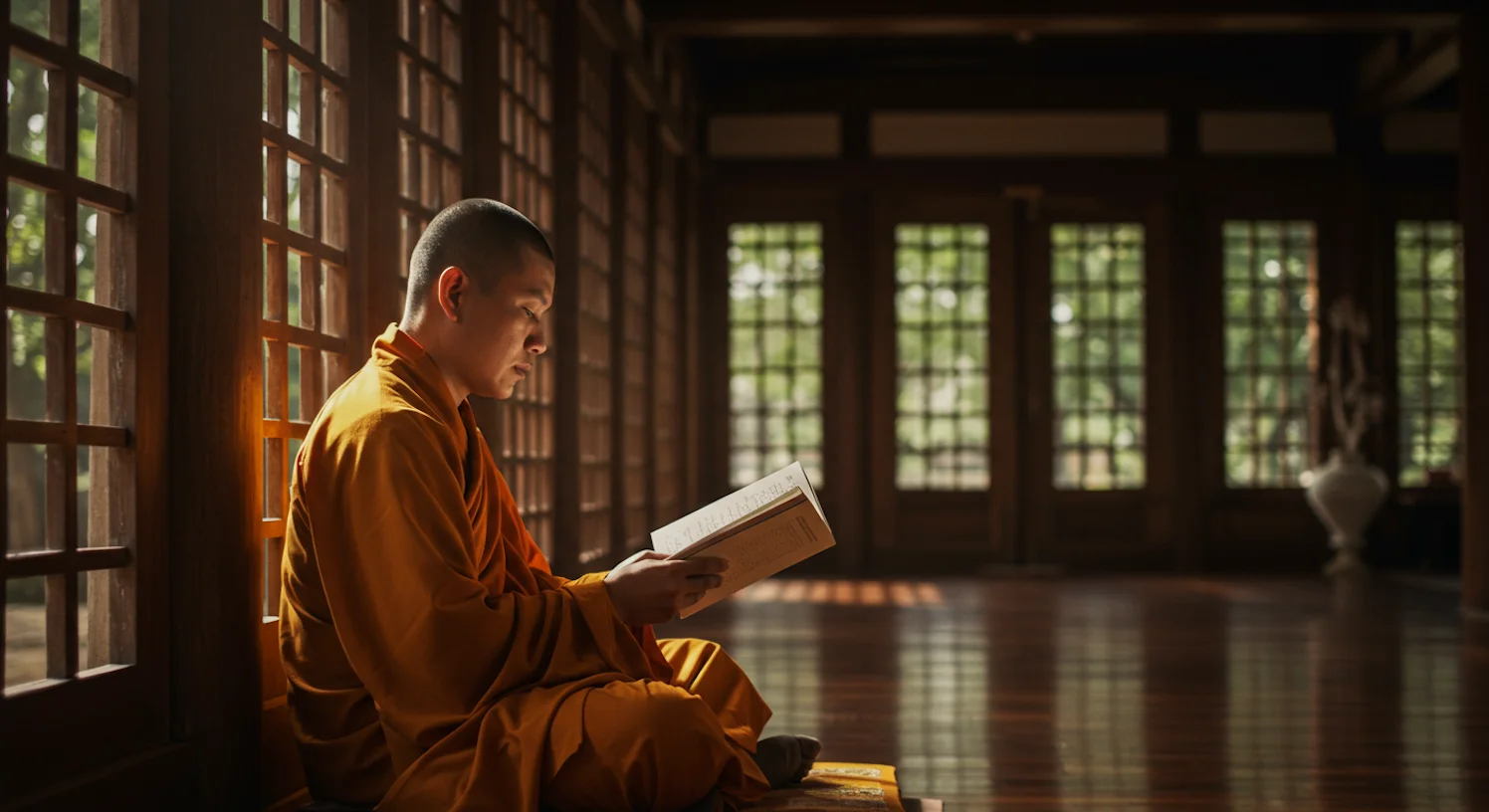Long before spiritual books decorated bookshelves worldwide and meditation apps existed to help normalize being “zen,” there were Buddhist sutras.
If you’ve ever sat in silence hoping for peace and wondered what the Buddha actually taught, then they may be the answer you’re looking for.
“The sutras are seed sounds,” says Deborah King, a spiritual teacher, author of the New York Times best-selling book Be Your Own Shaman, and one of Mindvalley’s most revered personal transformation trainers.
There’s a reason why they’re passed down from monk to monk and somehow still alive in the 21st century. The truth, alas, is eternal, and it never expires.
What are the Buddhist sutras?
Buddhist sutras are short passages that contain spiritual teachings.
The sutra means “thread” in Sanskrit. Contextually, it refers to a thread of verses that form a manual. And Buddhist sutras? They weave different teachings that were transmitted verbally from one generation of seekers to the next.
Eventually, these oral teachings became written collections like the Tripitaka in Theravada Buddhism and the Chinese Buddhist canon in Mahayana. These are what scholars now call the early Buddhist texts.
But if you think sutras are outdated, hold up. There’s a reason why your neighborhood monk would prescribe them to you amidst your life “hiccups.” They’re practical, bite-sized wisdom for people who need to remember life’s core truths in a single line, such as:
- All things are impermanent. What this means: Nothing stays. Not your highs or your lows. “This too shall pass” applies to everything.
- Form is emptiness, and emptiness is form. A job title, a body, a relationship… each of them, along with everything else in life, is a phenomenon in flux.
- Hatred does not cease by hatred, but by love. Like you don’t kill fire with fire but end it with water, you know?
- Nothing is to be clung to as “I” or “mine.” Your “self” isn’t a fixed state, because you’re a bundle of moving parts shaped by experiences and habits. Neuroscientifically and psychologically, it’s referred to as a construct.
In a world where everything shifts, sutras can hold you steady. No wonder they’re a core practice in Buddhism. The idea, as defined by renowned Buddhist monk Gelong Thubten, is to “build compassion so that it becomes our default state, rather than just an emotional reaction.”
A list of Buddhist sutras
The Buddhist canon is vast, comprising thousands of texts and hundreds of teachings. But just how many sutras are there? Well, in short… over 2,000.
A few have stood the test of time, chanted from cave monasteries to city temples. Google “Buddhist sutras for beginners,” and you’ll likely encounter them:
- Heart Sutra: Emptiness as a lived experience
- Diamond Sutra: Cuts through illusions of ego and self
- Lotus Sutra: Universal Buddha-nature for all beings
- Lankavatara Sutra: Mind-only teachings and perception
- Metta Sutta: The path of loving-kindness and compassion
- Tathāgatagarbha Sutra: Buddha-nature as your baseline
- Vimalakirti Sutra: Wisdom without spiritual elitism
- Avatamsaka Sutra (or Flower Garland Sutra): A vast cosmological text central to Huayan Buddhism
- Nirvana Sutra: Explores Buddha-nature and the nature of deathlessness
- Samdhinirmocana Sutra: Yogācāra philosophy and the idea of ultimate truth
- Shurangama Sutra: Meditation, mind, and samadhi (the highest state of enlightenment)
- Brahmajala Sutra: Mahayana ethical precepts
- Mahaparinirvana Sutra: The Buddha’s final teachings on impermanence and liberation
- Dhammapada: Verses summarizing the Buddha’s teachings across time
- Sutta Nipata: Some of the oldest discourses in the Pali Canon on the challenges of a spiritually advanced life
- Anapanasati Sutta: Breath-based mindfulness meditation
- Satipatthana Sutta: The four foundations of mindfulness
- Aggañña Sutta: A mythological and social origin story
- Itivuttaka: Concise teachings on ethics and insight
- Ratnakuta Sutra: A collection of Mahayana texts on compassion and wisdom
Some of these read like koans. Others like poetic manifestos. But each one is a direct transmission meant to be lived, not just studied.
In a world where nearly 30% of adults in the U.S. struggle with anxiety, often over things they can’t control, the sutras offer more than relief. Think of them as positive affirmations (which have been shown to help reinforce a strong sense of self), but forged in the fire of centuries-old spiritual practices and paths.
Who wrote the Buddhist sutras?
The short answer? Not just one person.
Most Buddhist sutras are attributed to Siddhartha Gautama, known to the world as the Buddha. But this ascended master didn’t write them down himself.
In fact, for centuries, not a single word of Buddhism was written at all. The teachings were passed orally by monks who memorized them word-for-word.
It wasn’t until around 400 BCE, after the Buddha’s death, that his disciples began organizing his spoken teachings into structured collections. These oral lineages were later written down and compiled into what we now call the Tripitaka and Mahayana.
Some sutras were translated and interpreted by scholars such as Kumārajīva, the monk who introduced many Mahayana sutras into the Chinese Buddhist canon. Meanwhile, others evolved as they passed through different cultures, absorbing local influences along the way.
That adaptability is exactly why sutras still resonate today. They flex with time, yet speak in the timeless language of the heart, just as they were meant to.
“The sutras were given in your native language. And that’s it. No explanation,” Deborah points out, reflecting on her own spiritual resonance with them. “But don’t be deceived by their simplicity. They are extraordinarily powerful.”
7 most important Buddhist sutras and their teachings
Out of the thousands preserved in the Buddhist canon, only a handful have shaped the spiritual backbone of generations. These are the sutras that monks still chant daily, that seekers still turn to in crisis, and that teachers still pass down.
And their benefits are activated in practice, which Deborah describes as compelling and forceful. “You have no idea where it could take you.”
Each of these teachings carries a function. Applied together, they build a system for waking up, one line at a time.
1. Heart Sutra: Feeling emptiness without going numb
First translated into Chinese in the 7th century by the monk Xuanzang, this Mahayana gem has echoed from Himalayan peaks to incense-lit temples in Tokyo. It’s short enough to chant before tea but dense enough to bend the mind of a scholar.
Its most iconic line, “form is emptiness, and emptiness is form,” has been touted as a reality check by ancient and modern monks alike. Everything you label, whether it’s your job, your heartbreak, or your ego, doesn’t last. This realization alone can free you from the weight of going through time, because life will always give you lemons.
Above all, this sutra teaches you to learn to feel without falling in and to observe your emotions without letting them consume you.
What’s great about this sutra is the understanding that you don’t need to always uncover the root of your pain points to start overcoming them. “You only have to feel the emotion to clear them,” explains Deborah.
Apply it when:
- You’re spiraling into overthinking.
- A relationship ends, and you want to let go, not harden from the breakup.
- Work is a source of identity that’s starting to suffocate you.
- You’re in grief, and sadly, nothing anyone says makes sense.
- You feel overwhelmed and need to get by… slowly.
When life gets loud, this sutra brings you back to the quiet truth underneath it all.
When we build compassion as our default state, we help change the world.
— Gelong Thubten, Buddhist monk and trainer of Mindvalley’s Becoming More Loving program
Experience the Heart Sutra’s full power here.
2. Diamond Sutra: Cutting through illusion, gently
First printed in 868 CE, the Diamond Sutra is one of the oldest known books and still one of the sharpest. It’s part of the Prajnaparamita school in Mahayana Buddhism, which literally means “perfection of wisdom.”
The name? It comes from the vajra, a mythical diamond-thunderbolt said to slice through anything, especially your ego.
Style-wise, the whole sutra is presented as a conversation between the Buddha and his student, Subhuti. Just blunt reminders like: let go of your identity. Let go of the idea of “me” doing anything. Even “spiritual goals” are traps if you cling to them.
Apply it when:
- The need to prove your worth is becoming a full-time job.
- Inner peace starts looking like another box to check.
- Thoughts spiral around how others perceive you.
- Your healing season starts to feel performative.
- Spiritual growth starts sounding more like pressure than presence.
The more you grip your own reflection, the more distorted life becomes. But when you loosen your hold on your identity-based roles or stories of trauma or where you are in the “hero versus victim” spectrum, you’ll see that what’s left is space. Clear, open space.
Enjoy the Diamond Sutra’s complete breadth here.
3. Lotus Sutra: Everyone’s invited to the party
Enlightenment back in the heyday was initially reserved for monks in caves or scholars with incense-thick libraries. But the Lotus Sutra changed that. It declared that every being, including laypeople, outsiders, and even those who are spiritually “messy,” carries Buddha-nature.
The clue’s in the name. The lotus blooms from mud, not marble. And that’s the point: spiritual awakening comes not despite your mess, but because of it.
Its stories are dramatic, its imagery wild. Think burning houses, rain from jeweled trees, and, amidst it all, a medicine-king bodhisattva who sets himself on fire as an offering of faith.
But beneath the theatrics is a simple message: your current form doesn’t limit your potential.
Apply it when:
- You feel like a fraud for not “being spiritual enough.”
- Comparing your healing to someone else’s journey.
- Old beliefs tell you you’re unworthy of awakening.
- You’re tempted to give up because you messed up.
- You just want to remember that it’s not too late to begin.
With this sutra, you’re reminded that your spiritual path is unique and it doesn’t have to look like anyone else’s. Nor does it need to be polished and perfect. It just needs to be fully yours.
Get the full poetic epic of the Lotus Sutra here.
4. Lankavatara Sutra: Understanding your mind is the way forward
For anyone curious where Buddhism and psychology meet, this is the sutra to study. It’s a cornerstone of early Zen (Chan) Buddhism, prized for its fierce focus on mind-only teachings.
Expect no frilly, elaborate metaphors here. Just raw inquiry into how perception creates reality.
The sutra teaches that it’s not the world that binds you, but how your mind interprets it. As the text puts it: “Thought is like a water-wheel… causing the wooden figures to move as a magician moves them.”
Apply it when:
- You keep replaying the past like it might change the ending.
- Someone’s opinion of you loops in your head for days.
- You want to break the habit of reacting on autopilot.
- You’re trying to understand how emotional triggers develop.
- You feel like your thoughts have hijacked your peace.
When the going gets tough and your mind won’t shut down, remember this rule of thumb: You’re not wrong for having thoughts. But the true access to freedom? It lies in knowing you don’t have to follow them all.
When in doubt, turn to Gelong’s wisdom (which sounds like a slice of the Lankavatara Sutra): “Every time the mind wanders and you return to the breath, you’re developing enormous power… you’re learning to choose what state to put your mind in.”
Uncover the Lankavatara Sutra’s full mind-only teachings here.
5. Metta Sutra: The art of fierce, consistent kindness
Not all sutras aim to unravel the mind. Some aim straight for the heart. The Metta Sutta, cherished in the Theravāda tradition, is one of the clearest instructions on how to live with boundless compassion.
Metta means “loving-kindness”… but don’t mistake that for soft sentimentality. This kind of love is a muscle. It’s trained through practice, especially when it’s hardest to give.
The sutra reads like a manual for living in harmony:
Be content. Be honest. Wish well for all beings, as “a mother protects with her life her child.”
And yes, that includes strangers. It even includes those who hurt you (hard, yes, but it’s not impossible).
Apply it when:
- You’re holding an old grudge that’s poisoning your current peace.
- Someone’s success is making you green-eyed with envy.
- Compassion feels conditional, a.k.a., “only if they deserve it.”
- The world’s suffering makes you want to shut down and never exit your bunker.
- You’re trying to love yourself, and it feels impossible.
The point of this sutra is forgiveness, which Gelong calls a huge source of power. Being capable of it, as he puts it, “means we are no longer being tormented.”
Read the Metta Sutta’s full verses on loving-kindness and peace here.
6. Tathāgatagarbha Sutra: You already are what you’re looking for
The Sanskrit term Tathāgatagarbha refers to the Buddha-nature inside all beings, covered up by fear, confusion, or karmic habits. In context, this Mahayana sutra centers the radical idea that you don’t have to try to become awakened because you already are.
The sutra likely emerged between the 3rd and 4th centuries CE and shaped the foundation of East Asian Buddhism. Its teachings were later expanded by scholars like Maitreya and Asanga, who helped formalize the Yogācāra school.
Throughout time, the heart of its message stayed the same: Awakening isn’t for the chosen few but a hidden baseline for everyone. In this vein, it’s similar to the Lotus Sutra.
But in its own way, this sutra invites you to pause, turn inward, and recognize that the divine spark is already within you.
Apply it when:
- Self-doubt creeps in, and you feel too broken to grow.
- You keep waiting to be “ready” to start healing.
- You’re stuck between who you were and who you’re becoming.
- “Lost” is still your middle name, even when you’ve tried everything to feel better.
Zoom out and look back. The Tathāgatagarbha Sutra is, in essence, monk mode dressed up as poetic parables that remind you to pause and be more present. And above all, it’s here to remind you not to compare yourself to others as you ground yourself.
“Even someone who seems completely successful, completely happy,” reminds Gelong. “We don’t know what’s going on under the surface.”
So, let this sutra spark the practice of showing up, mess and all. No need to wait for clarity or confidence. Just start where you are, with what you’ve got.
Observe your inner Buddha with the Tathāgatagarbha Sutra here.
7. Vimalakirti Sutra: True wisdom requires no polished robes
So you’ve built a regular meditation practice. You’ve studied the sutras, sat through silence, maybe even clocked a few “a-ha” moments that felt bigger than language. In a nutshell, you’re walking the walk, with your inner world honed in.
But here’s the twist no one warns you about: the road to self-mastery is a breeding ground for spiritual ego. You know, that sneaky voice that says, “I’m more awakened than they are.”
Here’s where the Vimalakirti Sutra gives you the plot twist. Written between the 1st and 2nd centuries CE, this Mahayana text centers a layperson, Vimalakirti, who “schools” monks and Buddha’s most elite disciples simply with his embodied wisdom… without ever flaunting robes, titles, or lineage.
When asked to explain non-duality, Vimalakirti said… nothing. And that silence? It shook the room he was in because it’s self-explanatory: that nothing is permanent or real.
So, whenever you’re low-key keeping score on how “conscious” you are, this sutra calls you out.
Apply it when:
- You’re doubting your worth because you think you’re not a “real” spiritual person.
- The urge to perform wisdom outweighs living it.
- Formal practice feels inaccessible or irrelevant.
- You’re overwhelmed by self-improvement but craving presence.
- You need permission to trust your lived experience.
In the end, wisdom isn’t in how well you recite the texts, how many retreats you’ve done, or whether your altar game is strong. It’s in how you show up… at the grocery store. With your partner. When plans fall through. When no one’s watching.
Explore the fullness of true presence in the Vimalakirti Sutra here.
7 ways to incorporate the wisdom of the sutras in modern spiritual practices
Sutras, according to Deborah, are life-changing. “But you have to do them,” she emphasizes. ”You have to practice.”
Translation? Wisdom means little if it’s just one paper. It has to be embodied via regular practice grounded in the right set of actions.
Here’s how to start living the sutras, sans that cave or mountain life:
- Start your day with one line. Pick a sutra verse. Repeat it mentally while brushing your teeth, walking to work, or waiting for your coffee.
- Incorporate them during meditation. Use your sit-down time to anchor your mind in the present moment. Loving-kindness meditation, for one, can dial up compassion.
- Chant them daily. Reciting sutras, whether aloud or silently, helps you entrain to the practice, Deborah says. When that happens, “it starts to respond.”
- Choose one as your walking mantra. Repeating a sutra while you’re earthing can deepen your focus. Choose a short one and sync it to your pace. It turns your errand run into a practice.
- Pair them with journaling. After reading or chanting a sutra, write what it evokes. Don’t overthink it; just respond as you feel. Let your subconscious mind express itself.
- Use them as conflict medicine. In moments of argument or tension, silently repeat a sutra of your choice. Let the energy of the verse interrupt your reaction loop.
- Explore Buddhist sutra books. The Dhammapada for bite-sized Buddha verses, In the Buddha’s Words for curated Pali Canon teachings, and The Heart of the Buddha’s Teaching by Thich Nhat Hanh for beginner-friendly insights. All timeless yet relatable.
As you can see, sutras don’t need quoting to be taught.
As Gelong puts it, “When we build compassion as our default state, we help change the world.” So let the sutras help you be that ripple of change.
Real stories, real shifts
Think sutra practices only work for mountain monks or full-time seekers? Let these Mindvalley members change your mind about the might of the Buddhist sutras:
“Before this, I felt lost, miserable, and angry with life. Now I don’t know what life is without my morning meditation and sutra practice,” shares Sana, a project manager in Toronto. “Even when things aren’t going right, I feel at peace. I’ve become a better listener. More self-aware. I love the version of me that’s emerging.”
Meanwhile, for the Stuttgart-based student Kornelius, his end goal was clarity. “I had pretty bad mental problems. But [the sutras] helped me find clarity, especially through the meditation,” he says, adding that he’d recommend them to everyone. “It’s truly life-changing.”
And there’s Ruhama from New York, who turned to the sutras to build more momentum into his life. “I had no job, no direction, and was separated from my kids. I started doing sutras daily—and everything changed.” Not only did he land his dream job, but he could also reunite with his family and even launch his own business. “My life finally feels aligned.”
Each of them brought the practice into everyday life, step by step, mantra by mantra, breath by breath. They prove that the power of these ancient lines lives in that rhythm—and the person you become because of them.
Awaken your spiritual superpower
The Buddhist sutras are proof that the best tools that uplift your souls are often compact, powerful, and ready to meet you wherever you are.
And if you’re curious how to take your next spiritual step without flying to the Himalayas or decoding Sanskrit scrolls, Mindvalley’s free soul-searching resources can be your next checkpoint. Inside, you’ll find various personal growth tools, including:
- The Manifestation Journal to help you put your inner truth on paper,
- Soul-Searching Questions, which get you to understand your soul’s deepest desires and purpose;
- Free spiritual masterclasses led by world-class spiritual and transformation experts like Regan Hillyer, Jeffrey Allen, and Mindvalley’s founder and CEO, Vishen, to guide you back home to yourself.
And there’s plenty more where these come from.
Pick one to start with, or dive into them all. Either way, your road to transformation begins when you let them in and guide you, just like a sutra would.
Welcome in.








